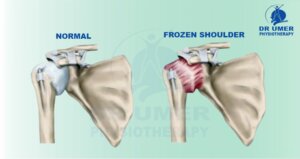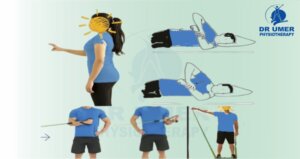
What is Frozen Shoulder?
Frozen shoulder is also known as adhesive capsulitis, causing pain and stiffness in the shoulder mostly affecting the ages of 40 to 60. Physiotherapy for Frozen Shoulder is really important because physiotherapy will increase range of motion and manage your pain. Frozen shoulder is classically described in three phases.
Phase 1: Freezing
The first phase is freezing phase. Clinically patients come with complain of pain but not so much stiffness. This phase will recover in 6 weeks to 9 months.
Phase 2: Frozen
The second phase is frozen phase, in which pain actually often diminishes but the shoulder can be markedly stiff and the movement of shoulder becomes limited. This phase will recover in 4 to 6 months.
Phase 3: Thawing
The third phase is the thawing phase (recovery phase), in which ability to move shoulder slowly improves or near to recover and normal strength. It takes 6 months to 2 years.
In many cases, frozen shoulder or adhesive capsulitis is a self-limited condition, meaning that eventually it does get better, sometimes completely on its own but that process can take sometimes up-to two years or more. If you can make that diagnosis early, you may be able to avoid that process of stiffness.
I would recommend as a first step seeing your primary care doctor and discussing the problem and the next step may be referral to physical therapy for Physiotherapy for Frozen Shoulder.
I think the key is gentle physical-therapy under the direction of a skilled physical therapist and it can be beneficial to maintain the range of motion.
Common Causes of Frozen Shoulder
The ligaments around the shoulder joint that became inflame and painful. This inflammation cause thickening of the capsule and the ligaments.
Frozen shoulder happens due to injury and surgery of shoulder or any upper body part. The most common causes of frozen shoulder is;
- Diabetes
- High cholesterol
- Heart disease
- Parkinson’s
When should I consult a physical therapist?

- You have sharp or unbearable pain during exercise and also pain at resting position.
- You have questions or concerns about your shoulder pain.
Physiotherapy of Frozen Shoulder

Shoulder flexion stretch:
Stand facing the wall, slowly walk your fingers up the wall and feel a stretch. Hold the stretch for 30 seconds. Back to the starting position.
Sleeper stretch:
Lie on your affected side on a flat surface. Bend the elbow of your affected arm 90° with your hand facing up. Use your second arm to push your affected arm down. Stop when you feel a stretch at the back of your affected shoulder. Hold the stretch for 30 seconds. Slowly return to the starting position.
Banded internal rotation:
With the elbow bent to 90 degrees place a towel under the arm to maintain a neutral shoulder position, holding a band and stretch towards your stomach. and Slowly control back to the start.
Banded external rotation:
Will be set up in a similar position but you will now rotate outward throughout the entire motion try and keep your elbow bent to 90 degrees.
Shoulder abduction:
You will perform a single arm lateral raise with a band stand on a band to anchor it. Raise your arm outward to about shoulder height.
Weighted supine external rotation:
Hold a weight even as little as one pound and rotate your arm outward. Start with your arm at your side and as your motion improves move your arm further away from your body working up to 90 degrees of shoulder abduction.
Supine single arm weighted pullover:
Keep your elbows straight and low back flat to the floor while you pull a weight overhead, as far as comfortable as range of motion improves you can progress by performing on a bench or elevated surface.
Perform these exercises for two to three sets of 10 to 15 repetitions every other day or as needed.
We also routinely employ the use of intra-articular corticosteroid injections, which is an injection of corticosteroid that’s done directly into the shoulder joint, so if the patient is not getting better over a certain period of time, they may be a candidate for some type of intervention.


